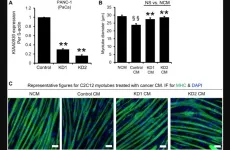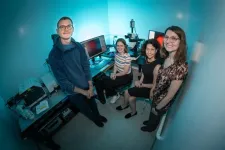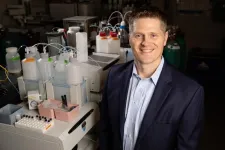(Press-News.org) WASHINGTON, D.C. — The U.S. Department of Energy (DOE) today announced $33 million to support 14 clean-energy research projects as part of a program to ensure the Department’s research funding is reaching pockets of the country that traditionally have received disproportionally low amounts of Federal scientific funding. The projects will cover a range of topics—including grid integration, renewable solar and wind energy, and advanced manufacturing. Today’s funding will help ensure all regions of the country share in the ownership of priority research that advances science and addresses energy and environmental issues as the country moves ahead to reach the Biden-Harris Administration’s ambitious climate goals.
“America’s next big energy breakthrough can come from anywhere in the nation, and that’s why Federal R&D investments should reach and benefit all parts of the country,” said U.S. Secretary of Energy Jennifer M. Granholm. “The funding we’re announcing today will spur innovation and create energy jobs around the nation.”
This funding—provided through DOE’s Established Program to Stimulate Competitive Research (EPSCoR) program—is intended to improve geographic distribution of Federal research and development funds and strengthen research capabilities in underserved regions of the country. There are 28 jurisdictions designated under EPSCoR, including 25 states and three U.S. territories.
Projects selected in today’s announcement cover a range of energy research topics, from fundamental science topics to efforts in fusion energy, climate and ecosystem modeling, grid integration, wind energy, and sensors for energy conversion.
Boise State University (Boise, Idaho): Addresses understanding needed to design dye components that may be used for quantum computing.
Jackson State University (Jackson, Miss.): Discovering how interactions of thin layer materials with bulk materials can boost electronic and heat-conduction properties to improve energy efficiency in electronics.
University of Alaska Fairbanks (Fairbanks, Alaska): Working to modernize our power grid to fully accommodate renewable energy sources.
University of Kentucky (Lexington, Ky.): Understanding how materials selection and pattern geometry impact light-matter interactions in nanoscale magnets arrays.
University of Maine (Orono, Maine): Preparing sensors to monitor and control energy conversion systems.
University of Nebraska–Lincoln (Lincoln, Neb.): Developing and applying new experimental and computational tools to understand dynamics of chemical reactions in organic materials.
University of Nebraska Omaha (Omaha, Neb.): Developing new magnetic and superconducting materials for potential applications in energy storage and conversion, data storage, and medical imaging.
University of Nevada, Reno (Reno, Nev.): Developing understanding to build stable controllable spin systems for quantum information sciences and quantum computing.
University of New Hampshire (Durham, N.H.): Developing models for marine atmosphere boundary layers to address atmospheric turbulence and impact on wind turbine performance.
University of New Mexico (Albuquerque, N.M.): Understanding the impacts of changing headwater stream networks on surface water quality, habitats and ecosystem response.
University of Rhode Island (Kingston, R.I.): Building and testing response systems to protect floating wind turbines and maximize power production during difficult weather conditions.
University of Southern Mississippi (Hattiesburg, Miss.): Developing a high‐throughput approach for the development of polymeric membranes, leveraging machine learning, autonomous synthesis, and neutron and synchrotron characterization.
University of Wyoming (Laramie, Wyo.): Addressing and reducing uncertainty across scales in global climate change models.
West Virginia University Research Corp. (Morgantown, W.V.): Characterizing ionized gases or plasmas whose applications range from understanding solar flares, to advanced rocket propulsion, to building fusion power systems.
Projects were chosen based on competitive peer review under a DOE Funding Opportunity Announcement for EPSCoR Implementation Grants. The DOE EPSCoR program is managed by the Department’s Office of Science through its Office of Basic Energy Sciences (BES). Projects announced today are selections for negotiation of financial award.
Planned funding will total approximately $33 million in Fiscal Year 2023 dollars for two-year projects. A list of projects can be found on the BES homepage.
END
DOE announces $33 million to advance energy research across America
Funding supports 14 projects ranging from fusion to quantum computing in parts of the country that get disproportionally low amounts of federal research dollars
2023-07-26
ELSE PRESS RELEASES FROM THIS DATE:
Predicting lifespan-extending chemical compounds for C. elegans with machine learning
2023-07-26
“We created datasets for predicting whether or not a compound extends the lifespan of C. elegans [...]”
BUFFALO, NY- July 26, 2023 – A new research paper was published in Aging (listed by MEDLINE/PubMed as "Aging (Albany NY)" and "Aging-US" by Web of Science) Volume 15, Issue 13, entitled, “Predicting lifespan-extending chemical compounds for C. elegans with machine learning and biologically interpretable features.”
Recently, there has been a growing interest in the development of pharmacological interventions targeting ...
KIAA0930: A cachexic phenotype inducer in cancer cells
2023-07-26
“We believe that KIAA0930 would be a novel cachexia therapeutic target.”
BUFFALO, NY- July 26, 2023 – A new research paper was published in Oncotarget's Volume 14 on July 20, 2023, entitled, “The uncharacterized transcript KIAA0930 confers a cachexic phenotype on cancer cells.”
Patients with cancer cachexia have a poor prognosis and impaired quality of life. Numerous studies using preclinical models have shown that inflammatory cytokines play an important role in the development of cancer cachexia; however, no clinical trial targeting cytokines has been successful. Therefore, ...
Lifespan of ageing science’s model organism driven by reproductive self-destruction
2023-07-26
The lifespan of a small roundworm that has been used as a key model organism in ageing research is limited by how it self-sacrifices to feed its young, finds a new study led by UCL researchers.
The authors of the new Nature Communications paper say their findings raise questions about how well insights from the Caenorhabditis elegans (C. elegans) worm can be translated to human ageing advances.
C. elegans is widely used as a laboratory animal, and has been central to ageing research for 40 years thanks to discoveries of genes that can be supressed to produce up to a tenfold increase in ...
A study outlines the optimal strategy for accelerating the energy transition in China
2023-07-26
China has set itself the goal of reaching its peak of carbon dioxide emissions in 2030 and thereafter to reduce emissions to reach carbon neutrality by 2060. To achieve this, it needs to increase photovoltaic (PV) and wind power to 10-15 petawatt hours (PWh) by 2060.
However, according to historical installation rates and a recent high-resolution energy-system-model and forecasts based on China's 14th Five-Year Energy Development Programme (CFEDP), the capacity of China for producing non-fossil-fuel energy will reach a maximum of only 9.5 PWh per year by 2060.
Now, an international study with the participation ...
How eavesdropping viruses battle it out to infect us
2023-07-26
Viruses, like movie villains, operate in one of two ways: chill or kill.
They can lay low, quietly infiltrating the body’s defenses, or go on the attack, exploding out of hiding and firing in all directions. Viral attacks are almost always suicide missions, ripping apart the cell that the virus has been depending on. The attack can only succeed if enough other healthy cells are around to infect. If the barrage of viral particles hits nothing, the virus cannot sustain itself. It doesn’t die, since viruses aren’t technically alive, but it ceases to function.
So for a virus, the key challenge is deciding when to flip from chill mode into kill mode.
Four years ago, Princeton ...
Unraveling a protein that may inspire a new biotechnology tool
2023-07-26
COLUMBUS, Ohio – Scientists have unraveled the step-by-step activation process of a protein with a deep evolutionary history in all domains of life, opening the door to harnessing its functions for use as a biotechnology tool.
The protein belongs to the “superfamily” of Argonaute proteins, which previous research has suggested to be involved in gene silencing, a fundamental process known as RNA interference.
These proteins are well-characterized in eukaryotes – the plants, fungi, animals, humans and other life forms with cells that have a defined ...
Study: Insect protein slows weight gain, boosts health status in obese mice
2023-07-26
URBANA, Ill. — As the global population grows under a changing climate, the urgency to find sustainable protein sources is greater than ever. Plant-based “meat” and “dairy” products may be popular, but they’re not the only environmentally friendly meat alternatives.
A new study in mice from the University of Illinois Urbana-Champaign suggests replacing traditional protein sources with mealworms in high-fat diets could slow weight gain, improve immune response, reduce inflammation, enhance energy metabolism, and ...
Recent advances in research to identify sources of nano- and microplastics
2023-07-26
Exposure to microplastics and nanoplastics — particles smaller than 5 millimeters and 1 micrometer across, respectively — have been linked to adverse health outcomes. Although some of their sources are well known, others haven’t been thoroughly vetted yet. Below are recent papers published in ACS journals that report new insights into the origins of some microscopic plastic pieces: laser-cut acrylic sheets, orthodontic rubber bands and children’s food containers. Reporters can request free access to these papers by emailing newsroom@acs.org.
“Characterization ...
Mount Sinai researchers uncover how mammary glands control overall energy balance and fat metabolism
2023-07-26
An Icahn School of Medicine at Mount Sinai study sheds light on the intricate interplay between mammary adipose (fat) tissue and breast health, and offers exciting possibilities for understanding breast development, lactation, cancer, and obesity and related metabolic disorders.
The study was published today in Nature. The research team was led by Prashant Rajbhandari, PhD, Assistant Professor of Medicine (Endocrinology, Diabetes and Bone Disease), and a member of the Diabetes, Obesity, and Metabolism Institute at Icahn Mount Sinai.
The ...
Study in journal Nature Communications finds high blood glucose levels sensitizes pancreatic cancer cells to chemotherapy
2023-07-26
CLEVELAND - Pancreatic cancer is one of the most difficult cancers to treat, being highly resistant to chemotherapy.
However, there are no effective alternative therapies to chemotherapy, so chemo remains the best available treatment.
Although there are fewer than roughly 60,000 new cases of pancreatic cancer diagnosed annually in the U.S., about 95 percent of people with it die from it, mainly because it often goes undetected in early stages.
Approved multi-agent chemotherapy regimens offer a marginal advance over single-agent ...
LAST 30 PRESS RELEASES:
Scalable and healable gradient textiles for multi‑scenario radiative cooling via bicomponent blow spinning
Research shows informed traders never let a good climate crisis go to waste
Intelligent XGBoost framework enhances asphalt pavement skid resistance assessment
Dual-function biomaterials for postoperative osteosarcoma: Tumor suppression and bone regeneration
New framework reveals where transport emissions concentrate in Singapore
NTP-enhanced lattice oxygen activation in Ce-Co catalysts for low-temperature soot combustion
Synergistic interface engineering in Cu-Zn-Ce catalysts for efficient CO2 hydrogenation to methanol
COVID-19 leaves a lasting mark on the human brain
Scientists use ultrasound to soften and treat cancer tumors without damaging healthy tissue
Community swimming program for Black youth boosts skills, sense of belonging, study finds
Specific depressive symptoms in midlife linked to increased dementia risk
An ‘illuminating’ design sheds light on cholesterol
Who is more likely to get long COVID?
Study showcases resilience and rapid growth of “living rocks”
Naval Research Lab diver earns Office of Naval Research 2025 Sailor of the Year
New Mayo-led study establishes practical definition for rapidly progressive dementia
Fossil fuel industry’s “climate false solutions” reinforce its power and aggravate environmental injustice
Researchers reveal bias in a widely used measure of algorithm performance
Alcohol causes cancer. A study from IOCB Prague confirms damage to DNA and shows how cells defend against it
Hidden viruses in wastewater treatment may shape public health risks, study finds
Unlock the power of nature: how biomass can transform climate mitigation
Biochar reshapes hidden soil microbes that capture carbon dioxide in farmland
Reducing saturated fat intake shows mortality benefit, but only in high-risk individuals
Manta rays create mobile ecosystems, study finds
Study: Mixed results in using lipoic acid to treat progressive multiple sclerosis
Norbert Holtkamp appointed director of Fermi National Accelerator Laboratory
New agentic AI platform accelerates advanced optics design
Biologists discover neurons use physical signals — not electricity — to stabilize communication
Researchers discover that a hormone can access the brain by hitchhiking
University of Oklahoma researcher awarded funding to pursue AI-powered material design
[Press-News.org] DOE announces $33 million to advance energy research across AmericaFunding supports 14 projects ranging from fusion to quantum computing in parts of the country that get disproportionally low amounts of federal research dollars



